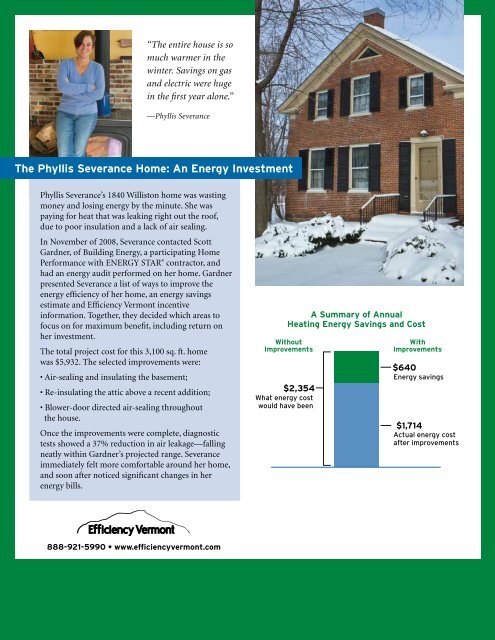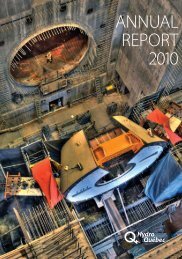Efficiency VT Energy Improvement Case Study ... - VTDigger.org
Efficiency VT Energy Improvement Case Study ... - VTDigger.org
Efficiency VT Energy Improvement Case Study ... - VTDigger.org
You also want an ePaper? Increase the reach of your titles
YUMPU automatically turns print PDFs into web optimized ePapers that Google loves.
“The entire house is so<br />
much warmer in the<br />
winter. Savings on gas<br />
and electric were huge<br />
in the first year alone.”<br />
—Phyllis Severance<br />
The Phyllis Severance Home: An <strong>Energy</strong> Investment<br />
Phyllis Severance’s 1840 Williston home was wasting<br />
money and losing energy by the minute. She was<br />
paying for heat that was leaking right out the roof,<br />
due to poor insulation and a lack of air sealing.<br />
In November of 2008, Severance contacted Scott<br />
Gardner, of Building <strong>Energy</strong>, a participating Home<br />
Performance with ENERGY STAR ® contractor, and<br />
had an energy audit performed on her home. Gardner<br />
presented Severance a list of ways to improve the<br />
energy efficiency of her home, an energy savings<br />
estimate and <strong>Efficiency</strong> Vermont incentive<br />
information. Together, they decided which areas to<br />
focus on for maximum benefit, including return on<br />
her investment.<br />
The total project cost for this 3,100 sq. ft. home<br />
was $5,932. The selected improvements were:<br />
• Air-sealing and insulating the basement;<br />
• Re-insulating the attic above a recent addition;<br />
• Blower-door directed air-sealing throughout<br />
the house.<br />
Once the improvements were complete, diagnostic<br />
tests showed a 37% reduction in air leakage—falling<br />
neatly within Gardner’s projected range. Severance<br />
immediately felt more comfortable around her home,<br />
and soon after noticed significant changes in her<br />
energy bills.<br />
$2,354<br />
What energy cost<br />
would have been<br />
A Summary of Annual<br />
Heating <strong>Energy</strong> Savings and Cost<br />
Without<br />
<strong>Improvement</strong>s<br />
With<br />
<strong>Improvement</strong>s<br />
$640<br />
<strong>Energy</strong> savings<br />
$1,714<br />
Actual energy cost<br />
after improvements<br />
888-921-5990 • www.efficiencyvermont.com
Paying for <strong>Energy</strong> <strong>Efficiency</strong> Home <strong>Improvement</strong>s<br />
The least expensive way to pay for energy improvements is with cash.<br />
Given the typical size of these projects, however, few homeowners have<br />
this option available. For Vermonters who are interested in making<br />
significant energy efficiency home improvements, appropriate financing<br />
can make the investment not only possible, but affordable.<br />
<strong>Energy</strong> savings can offset fixed monthly loan payments, and the money<br />
that would have been spent on energy bills becomes available to make<br />
most or all of the loan payments. Although the total cost of a longer loan<br />
is higher, increasing the number of payments can reduce the monthly cost<br />
and more closely match energy savings.<br />
Phyllis Severance’s Project Summary<br />
Total Project Cost ($5,932)<br />
<strong>Efficiency</strong> Vermont Incentive $680<br />
Total Customer Cost ($5,252)<br />
<strong>Energy</strong> Savings<br />
$640/yr.*<br />
PERSONAL SAVINGS<br />
Personal Savings Used $5,252<br />
Annual Interest Rate 1.00%<br />
Annual Interest $52<br />
Annual Cash Flow $588<br />
Instead of earning $52 in interest by keeping the<br />
money in her savings account, Severance would<br />
save $640 on her energy bills, coming out $588<br />
ahead the first year, and every year after that.<br />
FINANCING SCENARIOS<br />
7 yr. Personal Loan 15 yr. Home Equity Loan 30 yr. Mortgage<br />
Total Amount Borrowed ($5,252) ($5,252) ($5,252)<br />
Annual Interest Rate 7.50% 5.25% 4.75%<br />
Monthly payments ($81) ($42) ($27)<br />
Total Interest ($1,515) ($2,347) ($4,611)<br />
Total Cost ($6,766) ($7,599) ($9,862)<br />
Total <strong>Energy</strong> Savings<br />
During Repayment Period<br />
$4,480 $9,600 $19,200<br />
Cash Flow**<br />
Monthly ($27) $11 $26<br />
Annual ($327) $133 $311<br />
Total Cash Flow<br />
During Repayment Period<br />
($2,287) $2,001 $9,338<br />
If Severance decided to use a<br />
personal loan, she would need<br />
$2,287 over the term of the loan,<br />
in addition to the money from<br />
energy savings. Severance would<br />
continue to save $640* a year after<br />
the loan payments were complete.<br />
If Severance decided to use a home equity loan or mortgage, she could<br />
use the money that would otherwise have been spent on energy bills<br />
to make her loan payments, and still have money left over. Severance<br />
would continue to save $640* a year after the loan payments were<br />
complete.<br />
*Assumptions: <strong>Energy</strong> prices do not change during the life of the loan. All loans are fixed rate. <strong>Energy</strong> Savings are calculated based on<br />
Normal Season Heating Degree Days.<br />
**Cash Flow equals Total <strong>Energy</strong> Savings during repayment period minus Total Cost.




